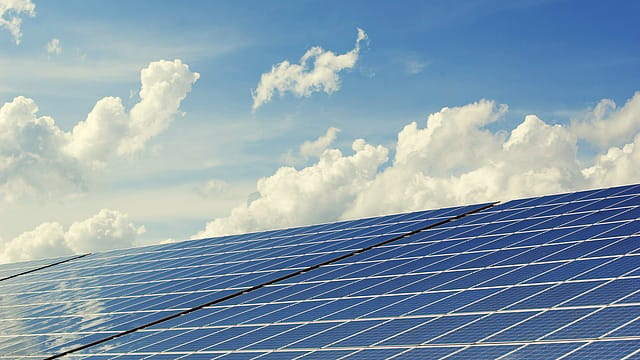Bridging the two fuels in an economy: energy and finance
ADVERTISEMENT

An energy revolution is under way. Globally, renewables-based electricity capacity has seen more investments than fossil fuels in the past three years.
Yet, many remain wary of investing in renewable energy particularly in developing countries, which have large untapped potential for both solar and wind energy. These are generally perceived as challenging markets in which to operate, especially by risk-averse investors.
So, why do clean energy investments continue to be viewed as risky, despite evident trends pointing to the contrary? More importantly, what are these risks and just how real are they?
Renewable energy projects in emerging economies face several real risks. Some are unique to the sector itself, such as technology risk or integration of infirm power supply. Other risks are economy-wide, such as currency risk, counter-party risk, policy and political risk, etc.
However, there is a third risk category that is playing spoilsport for clean energy markets in emerging economies: the perception of risk. Specifically, in the case of renewables, there is often a delta, or variance, between perceived risk and actual recorded risk. This arises from lack of data on actual ground realities, which results in lack of coherence among various stakeholders in the clean energy industry. This deters investment.
December 2025
The annual Fortune 500 India list, the definitive compendium of corporate performance, is out. This year, the cumulative revenue of the Fortune 500 India companies has breached $2 trillion for the first time. Plus, find out which are the Best B-schools in India.
In India, renewable energy is no longer a fringe player. Nearly 80 gigawatts (GW) have been installed and India is making timely progress on realising the target of 175 GW of renewable energy capacity by 2022. With variable renewables expected to contribute as much as 20% of generation capacity by 2022 (much higher shares if all renewable energy sources, including hydropower, are considered), there is a growing need to better understand the project-level performance of renewable energy assets and identify impediments that can retard progress. Continuous tracking of the sector and a strong data regime are needed for energy planning in the future, cost-effective monitoring and management of the grid. This will aid the process of reducing information asymmetries regarding renewable energy, and aid in better decision-making by system operators, policymakers, project developers, and investors.
Information asymmetry can be bridged with dedicated efforts to monitor market activity and increase transparency. The Central Electricity Authority recently formed a renewable energy monitoring division. At the Council on Energy, Environment and Water (CEEW), we have been collating project-level data, along with the International Energy Agency, to analyse trends in clean energy markets. Our most recent analysis indicates rising levels of market consolidation. Firms with access to financing on favourable terms dominated solar photovoltaic (PV) and wind auctions in 2018. The top 10 developers in the solar and wind sectors accounted for over 80% of the capacity awarded. This kind of information helps both existing and potential investors.
Further, growing familiarity with renewables has also boosted confidence among lenders, resulting in a decline in interest rate spreads over benchmark bank lending rates for both wind and solar PV by 75-125 basis points during 2014-2018. The reduction in interest rate spreads, coupled with improved bankability of projects, and improved debt-to-equity ratios for solar PV (80:20), and wind energy (75:25), is a significant contributor to rapidly reducing renewable energy tariffs in India to among the lowest in the world.
Tracking on-ground activity shines a light on the effectiveness of government action to make it easy to do business. The risk of land acquisition, access to evacuation infrastructure, and licences etc. has reduced thanks to solar parks. In 2017, 54% of total capacity added was in solar parks, driving down tariffs and attracting international power producers. The share dropped to 24% in 2018 due to a slowdown in solar park development, although absolute capacity awarded at solar parks remained largely unchanged.
But even as clean energy markets grow, persisting uncertainties slows down growth. In 2018, input costs rose when India imposed safeguard duties. The resulting market uncertainty translated into tariffs at solar auctions rising above the record lows realised in 2017. This was the main reason that nearly 5 GW of solar PV projects awarded in 2018 were cancelled, equivalent to around half the total solar capacity added in 2018.
Other dark clouds are gathering. Close to 5 GW of renewable energy capacity could be affected by Andhra Pradesh’s proposed renegotiation of power purchase agreements (PPAs). Sanctioned solar and wind projects could lose revenues to the tune of ₹3,500 crore every year. Most of these projects have Solar Energy Corporation of India (SECI) and NTPC as intermediaries, thereby impacting their ability to honour PPAs. If Andhra utilities did not honour power sale agreements with SECI and NTPC, it would expose fissures in the viability of the underwriting services that these intermediaries provide to developers.
Business is a combination of realism and sentiment. Bridging gaps between perception and reality can bring the two fuels in an economy—energy and finance—closer. This is necessary to lower the chances of investor sentiment swinging wildly between exuberance and vapidity. This is also necessary to ensure that policymakers make evidence-based decisions rather than keeping developers on tenterhooks. The energy transition in India and other emerging economies is a reality. Accelerating its pace needs more data transparency and hard-nosed analysis—in real time and without fear, favour, or prejudice.
Views are personal.
Kanika Chawla is director, CEEW Centre for Energy Finance; Arunabha Ghosh is CEO, Council on Energy, Environment and Water.
